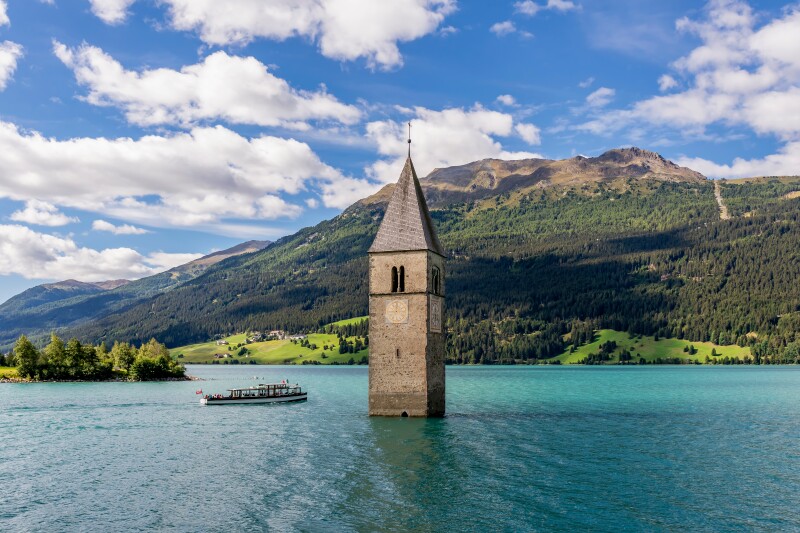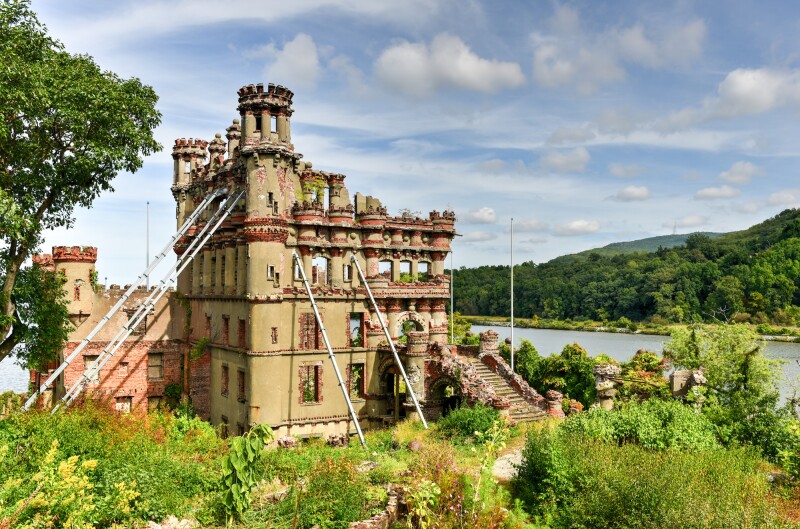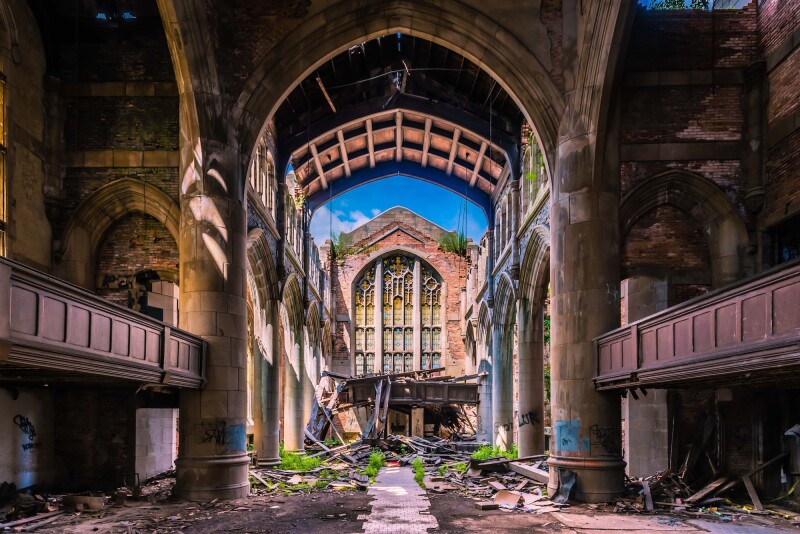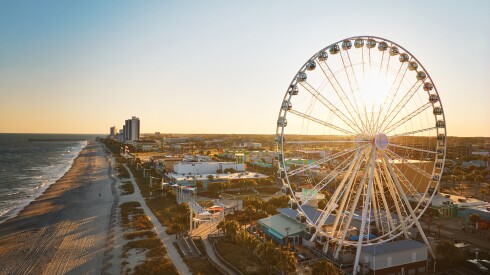There’s something special about peering into a space that isn’t regularly inhabited by humans. Even if you’re viewing these places through a computer screen, there’s a quiet reverence surrounding them. After all, they’re usually abandoned for a very real reason. Much like a museum, the world’s abandoned spaces also offer a niche kind of perspective. These sites are particularly visually compelling, but they also serve as important reminders of history, from an out-of-use art nouveau subway station beneath New York City to a sand-covered ghost town on Namibia’s Atlantic Coast. Here are 17 abandoned places around the world that you can visit.

The Haludovo Palace Hotel used to be one of the most glamorous stays in all of Europe before a civil war broke out in the Balkans.
Photo by xbrchx/Shutterstock
1. Haludovo Palace Hotel
Krk, Croatia
Hotels come and go, but not all of them were as luxurious as the Haludovo Palace on Croatia’s largest island, Krk. Despite being abandoned for more than three decades, you can still see its past opulence in the modern exterior and massive (now drained) pool. The property was opened in 1972, and Penthouse magazine founder Bob Guccione was an investor, dropping $45 million into what would become the Penthouse Adriatic Club. Here, wealthy hotel guests would gamble and be treated to caviar, lobster, and champagne. There were also bowling lanes and tennis courts on site. In 1991, the property closed down as the civil war broke out, and it later served as a base for refugees. Now, the property is completely overrun with weeds and covered in glass—people have visited in the time between, but no official tours are operating in the area.

You can thank artist Jakub Hadrava for the spooky ghost sculptures that now populate this church.
Photo by rudnitskaya_anna/Shutterstock
2. St. George’s Church
Luková, Czechia
Get ready, this one is a bit spooky. Abandoned in 1968, St. George’s Church still stands and currently houses a whole crew of “ghosts.” But the story of why it was deserted only adds to the story of its current tenants. The structure was first built in the 14th century to serve the local community in this town about 120 miles east of Prague. In 1968, the church’s roof collapsed during a funeral, resulting in many of the congregation believing it was haunted. So, they began to congregate outside to worship, leaving the interior to deteriorate. As the building fell into more disrepair, the community unsuccessfully tried to raise money to renovate it. Enter local artist Jakub Hadrava. He played off of the folklore and constructed 32 life-size ghost sculptures that sit among the pews. The church is open on Sundays for those brave enough to take a closer look.

The construction of a dam flooded old villages, leaving just the top of this bell tower above the surface of the water.
Photo by Marco Taliani de Marchio/Shutterstock
3. Lago di Resia (Lake Reschen) Bell Tower
South Tyrol, Italy
There’s a good chance you’ve seen a photo of this eerie bell tower on Instagram. Half-submerged in water, it’s a mark of the valley that used to exist before a large dam was created to support the local hydroelectric company and merged two natural bodies of water: Mittersee and Reschensse. In addition to the two lakes becoming one, the flooding overtook the villages of Arlung, Piz, Gorf, Stockerhofe, Piz, Curon, and sections of Reschen. Hundreds of homes and farms were swallowed, along with most of the Church of St. Catherine. In an attempt to level the land, the energy company set off explosives to reduce buildings to rubble, but the 14th-century bell tower was left behind because of its long history. As beautiful as it may be, for many it’s a reminder of the heartache locals endured to relocate themselves and loved ones buried in the local cemeteries.

Mangrove trees have taken over the abandoned SS Ayrfield in Sydney’s Homebush Bay.
Photo by Duncan Struthers/Shutterstock
4. SS Ayrfield Shipwreck
Sydney, Australia
During the 20th century, Sydney’s Homebush Bay served as an industrial port and was filled with ships that transported coal and oil. But when the area’s industrial operations declined toward the end of the century, the bay became a “ship-breaking ground” for decommissioned vessels. Today, you can still see some of the abandoned freighters across Homebush Bay, including the SS Ayrfield, a 1911 vessel that carried supplies to U.S. troops in the Pacific region during World War II. The boat was deregistered in 1972 and now floats in the bay, overgrown with mangrove trees.

In Bolivia’s Altiplano, abandoned train cars that have been weathered by salt and winds are also painted with graffiti.
Photo by TurneroundDesigns/Shutterstock
5. Great Train Graveyard
Uyuni, Bolivia
Located high in the Andean plains of southwest Bolivia, the small city of Uyuni is known for its proximity to the world’s largest salt flat, Salar de Uyuni. But the area is also home to another unique attraction: a “train cemetery” (known as cementerio de trenes in Spanish) scattered with abandoned locomotives that date back to the 19th century. These massive steel trains were imported to the region as part of plans to develop a railway system that would transfer minerals from Uyuni to cities on the Pacific Coast. But after the area’s mining industry lost momentum, the project was canceled, and more than 100 train cars were left to rust. The trains have now been largely corroded by salt and heavy winds, but visitors are free to explore what remains; the grounds are less than 10 minutes by taxi from downtown Uyuni, and most local tour companies stop at the site en route to the salt flats.

Once a salt mine during the Middle Ages, Salina Turda has since been converted into an underground theme park.
Photo by Photokon/Shutterstock
6. Salina Turda Salt Mine
Turda, Romania
This colossal mine dates all the way back to the Middle Ages. Located in Transylvania, the hollowed underground space was the site of table salt production for hundreds of years until excavations eventually ended in the early 20th century. Since 1932, the cavern has been used for several purposes, including as a warehouse for cheese storage and a bomb shelter during World War II. In 1992, Salina Turda was repurposed again—this time as both a museum of salt mining and a subterranean amusement park that contains an amphitheater, a Ferris wheel, spa treatment rooms, a bowling alley, pool tables, and even an underground lake with rowboats. Tickets cost approximately $10 for adults, $7 for children.

In October 2019, Denmark’s Rubjerg Knude Lighthouse was “rolled” on iron plates and wheels to its new location over 200 feet from the North Sea coastline.
Photo by PhotoPhilipp/Shutterstock
7. Rubjerg Knude Lighthouse
North Jutland, Denmark
The Rubjerg Knude Lighthouse sits on a towering sand dune nearly 200 feet above Denmark’s North Sea. When it was first lit in 1900, the lighthouse was hundreds of feet from the Atlantic coastline. But over time, wind and sea erosion changed the landscape and turned the area around the lighthouse into sand dunes. The Rubjerg Knude Lighthouse shut down in 1968 but served as a museum and coffee shop from 1980 until 2002, when rising sands ultimately forced it to be abandoned completely. In October 2019, the landmark was “rolled” on a set of iron plates and wheels to a new location over 200 feet from the coastline, as the structure was at risk of falling into the ocean due to erosion and shifting sands. Visitors can still walk along the beach and view the structure for free.

Manhattan’s first subway station featured vaulted tile ceilings by Spanish engineer and designer Rafael Guastavino.
Photo by Felix Lipov/Shutterstock
8. City Hall Subway Station
New York City
New York City’s first subway station—which opened below City Hall in 1904—was adorned with vaulted ceilings, intricate tilework, and elegant chandeliers. The grandiose platform served commuters until 1945 but was shuttered after the majority of New Yorkers eventually opted to use nearby rail stations with more efficient express tracks. Today, the New York Transit Museum leads exclusive guided tours of the defunct City Hall station for $50 per person. You have to become a museum member for the chance to explore the New York landmark, and even then, tickets for the 90-minute train station tour tend to sell out quickly.

Craco, now a ghost town, was built during the Middle Ages on a cliff more than 1,000 feet tall.
Photo by illpaxphotomatic/Shutterstock
9. Craco
Matera, Italy
Founded precariously on a steep hilltop in southern Italy during the 8th century, the medieval village of Craco has fallen victim to several disasters, including earthquakes, landslides, and devastating plagues. In 1991, a landslide forced all of Craco’s remaining residents to evacuate, leaving the site in a state of slow ruin. While the village is now entirely uninhabited, visitors can marvel at the Basilicata region ghost town on daily tours led by authorized guides at the welcome center—no reservations necessary.

Before it was abandoned, Deception Island served as a whaling base and scientific research center.
Photo by Yongyut Kumsri/Shutterstock
10. Deception Island
South Shetland Islands, Antarctica
Deception Island is more than a water-surrounded landmass in Antarctica’s South Shetland Islands; it’s also an active volcano. In the early 20th century, the caldera served as a base for whaling operations, but it was abandoned many times—first in 1931 due to a slump in whale oil prices, and later in 1969 because of disruptive volcanic eruptions. Rusted tanks and boilers still scatter the Antarctic island alongside deteriorating research stations, beached boats, and a cemetery honoring workers who passed away there. Cruise lines such as Silversea and Oceanwide Expeditions offer voyages to Deception Island—if you’re lucky, you might spot some chinstrap penguins.

The dilapidated buildings that once housed German settlers have since been reclaimed by Namibia’s desert sands.
Photo by Kanuman/Shutterstock
11. Kolmanskop
Namib Desert, Namibia
Located in the barren Namib Desert, Kolmanskop boomed as a German diamond mining settlement during the early 1900s. After World War I, however, the area’s once-rich diamond field began to deplete and operations eventually came to a halt. By the end of the 1950s, German colonists had completely deserted the town, leaving the abandoned buildings of their settlement to be swallowed up by the southern Namibian sands. To explore what’s left of the sand-filled ghost town today, travelers must book a guided tour in the nearby tourist hub of Lüderitz, located on Namibia’s southern coast.

The now abandoned Hashima Island is considered a symbol of Japan’s rapid industrialization.
Photo by leungchopan/Shutterstock
12. Hashima Island
Nagasaki, Japan
Also known as Gunkanjima (meaning Battleship Island, for its resemblance to a Japanese battleship), this 16-acre-long island in Japan’s Nagasaki prefecture was once a densely populated place for undersea coal mining. Hashima Island functioned as a lucrative coal facility from 1887 until 1974 when the source ran out—after which Hashima’s population quickly left the island. The concrete “ghost island” was recognized as a UNESCO World Heritage site in 2015, and today, groups of visitors can go on tours with local companies such as the Gunkanjima Concierge Company, which start at $36 for adults and $29 for students.

Bodie was a booming mining town during the Gold Rush in California.
Photo by Boris Edelmann/Shutterstock
13. Bodie State Historic Park
Mono County, California
In the late 1800s, Bodie was a booming gold mining town with a population of more than 10,000 people. Today, the ghost town—approximately 75 miles southeast of California’s Lake Tahoe—has been preserved in a state of “arrested decay.” Over 50 buildings are still standing, some featuring preserved interiors that appear almost exactly as they were left. A handful of the abandoned buildings are open for the public to explore for an entrance fee of $8 for adults and $5 for children (cash only). During summer, the State Historic Park offers exclusive nighttime Ghost Mill Tours that feature legends and ghost stories about the town.

The decommissioned Tempelhof Airport was the site of Nazi rallies and the Berlin Airlift.
Photo by ravjot0286/Shutterstock
14. Tempelhof Airport
Berlin, Germany
Germany’s capital is a city full of abandoned buildings with complicated histories, among them the sprawling Tempelhof Airport. Straddling the city’s Neukölln and Tempelhof neighborhoods, this pre–World War II airfield was once one of the largest structures in Europe. It sat abandoned after it was shuttered in 2008, but reopened in 2010 as the largest public park in Berlin. Today, former airplane runways are used for biking, jogging, and skating, while grassy areas hold public events and urban gardens. The eerie, Nazi-era terminal is also open to wander and observe.
Berlin also has a few other abandoned places, such as an old children’s hospital, Hansastraße, sanitorium, Beelitz, and the amusement park, Spreepark Berlin.

Scottish collector Francis Bannerman built this New York castle not as a home, but as an arsenal for his immense weapons collection.
Photo by Felix Lipov/Shutterstock
15. Bannerman Castle
Pollepel Island, New York
About 50 miles north of New York City, Bannerman Castle sits on a patch of land known as Pollepel Island in the Hudson River. The dilapidated structure was erected at the start of the 20th century by Scottish immigrant Francis Bannerman, who worked as a military surplus goods collector and needed a warehouse in which to store his purchases. After Bannerman passed away in 1918, construction on the castle halted. Since then, a series of mysterious events have occurred (including a shell powder explosion and a tragic boat accident). Still, the Bannerman Castle Trust works to preserve the site; a variety of hard-hat walking tours are offered from May through October, and the words “Bannerman’s Island Arsenal” remain displayed on the castle’s side, making it easily visible to passengers on the Metro–North Hudson train line.

Kennecott is located in Alaska’s Wrangell–St. Elias National Park, the largest U.S. national park.
Photo by Steven Schremp/Shutterstock
16. Kennecott Mill Town
Wrangell–St. Elias National Park and Preserve, Alaska
This 20th-century copper mill town is listed on the U.S. federal government’s National Register of Historic Places. From 1911 to 1938, an estimated $200 million worth of copper was processed in Kennecott, a self-contained company village, which included its own hospital, general store, post office, and school. Of the historic buildings that make up the 2,800-acre ghost town, the main attractions include a 14-story concentration mill and a defunct power plant, both of which are only accessible by guided tour. Harsh winters in Alaska make Kennecott inaccessible, so the town’s visitor center is only open from Memorial Day to Labor Day.

City Methodist Church has appeared on the big screen in movies such as Nightmare on Elm Street and Pearl Harbor.
Photo by Boyd Hendrikse/Shutterstock
17. City Methodist Church
Gary, Indiana
Originally built in 1926 with money donated by the U.S. Steel Corporation, this Indiana church is a nine-story Gothic marvel with towering stone pillars and stained glass windows. During its prime, the City Methodist Church ministered to almost 2,000 people, but as the state’s steel industry faltered and Gary’s population dwindled, the congregation shut down in 1975. For years, the abandoned structure has been frequented (without permission) by urban explorers and eager photographers, but in 2017, the Gary Redevelopment Commission began plans to redevelop the crumbling church as a “ruins garden,” complete with an amphitheater for public events. It has yet to be completed.
This article originally appeared online in February 2019; it was most recently updated on February 26, 2024, to include current information.











